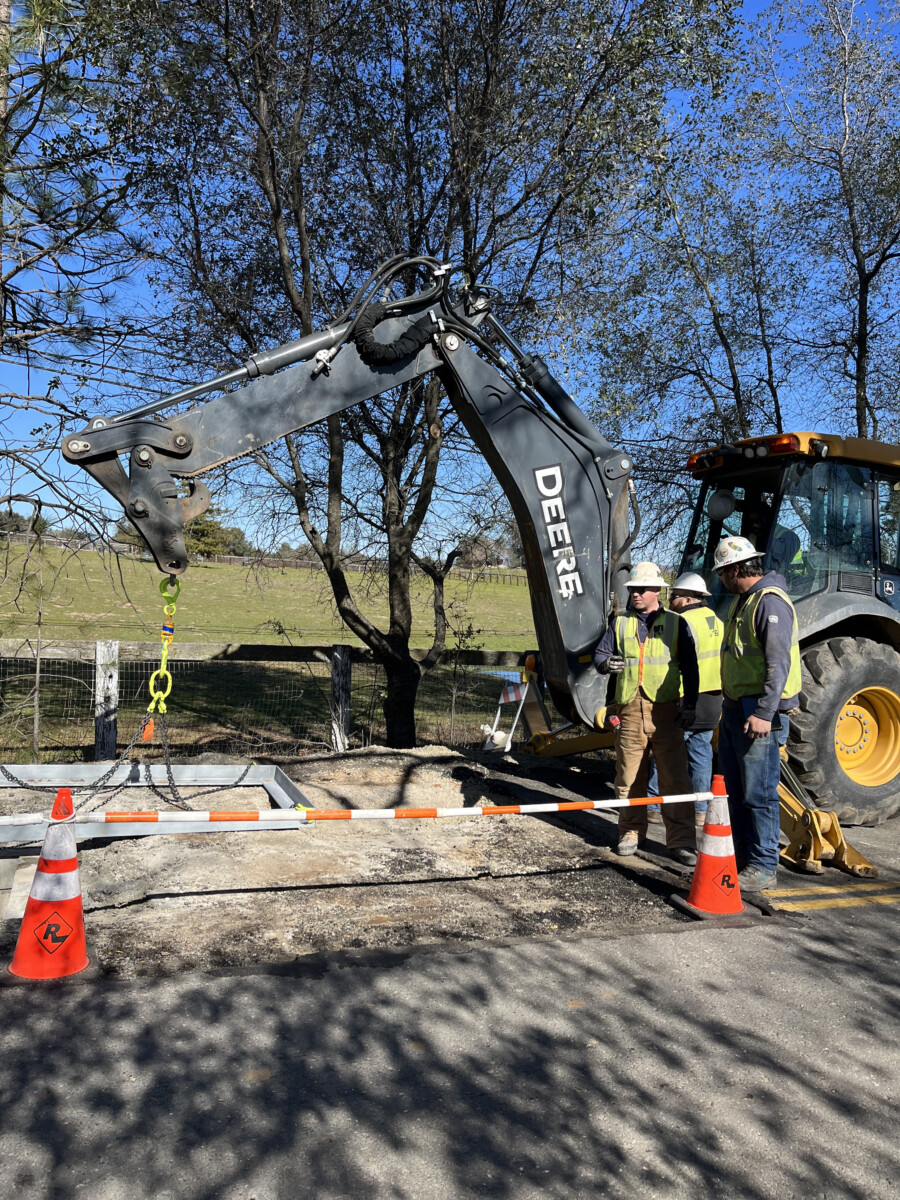
IBEW 1245 member and Working Foreman B Travis Sinfield explains installation of a frame for a heavy traffic splice box. Photo by Bob Gerstle
The temperature was barely above freezing, and the terrain was unforgiving, but none of that seemed to faze the IBEW 1245 GC Gas crew from PG&E when we took a trip out to their worksite in the Sierra foothills in early February.
The crew was 11 months into a challenging undergrounding job on the Shingle Springs 2109 circuit near Placerville. When we visited, they were on the tail end of the project, working on a three-mile section of newly installed underground substructures and conduit.
As is common in much of the Sierra foothills, the terrain is lava cap and can be next to impossible to dig in, much less trench – making the work anything but routine. But that’s never stopped our skilled and trained IBEW 1245 members, who took on the challenge confidently, with the expertise that only comes from years of experience and training working on utility infrastructure.
Since the start of the job in March 2022, Local 1245 crews have installed over five miles of conduit and more than 40 “heavy traffic” splice boxes (which are so heavy that they require workers who have a crane certification to install). At times, the total onsite manpower has been as high as 50 employees, including signatory contractors and flagging (El Dorado County requires a flagger at every driveway within a work zone, and there have been days with 16 flaggers on site because of this county rule).
While the terrain is difficult, heavy John Deere equipment and occasional blasting has made work a little more bearable. And of course, the climate in the Sierra foothills means that the crews worked in triple-digit heat over the summer, and bitterly cold temps in the winter. But despite all the challenging logistics, the 1245 members on this job haven’t had a single health or safety incident (with the exception of a third-party vehicle that drove through a cone zone and got into an open trench. The fact that our members avoided injury in that unexpected situation is a testament to the highly skilled and trained workers on this job.)
For Working Foreman B Travis Sinfield (who was running the job on the day we visited) and the other foremen who have been on the job, safety is always the top priority. Listening to the tailboard that Sinfield delivered to his crew, it was easy to understand how experience and comprehensive knowledge have been critical to the success of this job. Ergonomics, public safety, and looking out for each other were all topics emphasized in the tailboard.
Of the seven 1245 members working on this day, six live locally, including Crew Foreman Shawn Beauchamp, who hired on with PG&E at the age of 51. Beauchamp owned his own construction business until the recession hit in 2008, and came to PG&E looking for more security. He didn’t mind starting in a beginning level classification, and quickly proved his value and work ethic; demonstrating that his age and experience were in fact an asset. He lives nearly in Newcastle, an appreciates being on a job near his home, as do the other members of the crew.
“It’s important to us that we are working in the community in which we all live,” echoed Sinfield, noting that he personally appreciates being able to see his two-year-old son at home each night.
This is certainly not the norm for most GC Gas crews, who often find themselves on the road, but given PG&E’s aggressive ten-year undergrounding plan in high-threat fire areas, the expectation is that hotel rooms and time away from home will be limited.
The 1245 crews takes pride in the fact that the completion of this job will make the community they live in much safer from an ignition that could start a catastrophic fire, and also limit the potential for outages. The crew is looking forward to their next job, hoping it keeps them near home.
Soon, the electric crews will be back to pull cable and heat up the circuit — eliminating the overhead wire and the potential for a wildfire that goes with it.
Truly a win-win for the community and our IBEW 1245 members.
–Bob Gerstle, IBEW 1245 Senior Assistant Business Manager